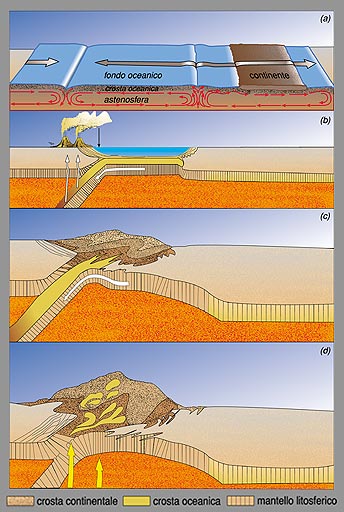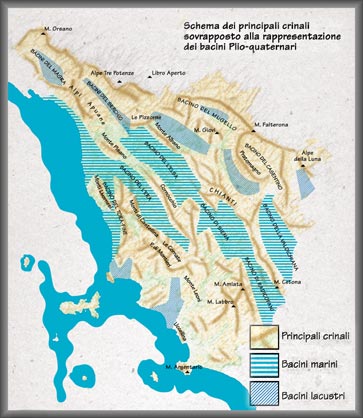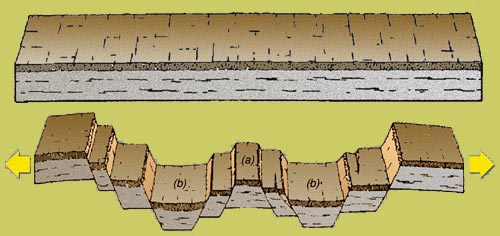In the early '60's, the theory of continental drift proposed by Alfred Wegener, later elaborated and completed in the "tectonic plates theory" was at last recognised as a stroke of genius which was to change the history of science.
The mechanism driving the movement of the plates, i.e. the cause which is today considered the most probable, is the convection currents in the mantle of our planet which disperse the internal heat of the earth, produced by radio-active decay of the elements.
Because of these movements of the crust (a) there are some areas of the Earth where magma rises, solidifies and forms new lithosphere (i.e. the solid part of the mantle plus the earth's crust).
Consequently, there are other areas where the lithosphere must sink down into the mantle where it melts.
These areas are called rift zones or oceanic ridges (rising) and subduction zones or oceanic trenches (sinking) respectively.
The continents, which are masses of lighter continental crust floating on the mantle, are no longer thought as "drifting", but rather forced to follow the convection currents (b).
When a continental plate reaches a subduction zone (c), it also tries to sink as it follows the denser oceanic crust, but as it is lighter it cannot and is forced to float.
So the continents, as they pile up against each other (d), form the corrugations and folds we call mountains, e.g. the Andes.
Another cause of orogenesis (mountain building) is the collision between two continents; this is how the Himalayas were formed when India and Asia collided.
The collision between Africa and Europe first saw the birth of the Alps and then the Apennines.
The geological history of the Tuscan hills is the result of the collision between Europe and Africa.
Whilst in Romagna, the Marches and in the Adriatic, this folding process is still underway, on the western side of the Peninsular, the Ligurian and Tyrrhenian seas as far as west Umbria and the upper Tiber Valley, distensive tectonics are in force, i.e. the formation of Hôrst e Graben running in a NW-SE direction along the Apennines.
The oldest tectonic foredeeps, to the west, were already open in the Upper Miocene, whilst the most recent, pertaining to the Valdarno and Upper Tiber Valley, date back to the Pliocene.
All these structures are still active and often cause earthquakes.






